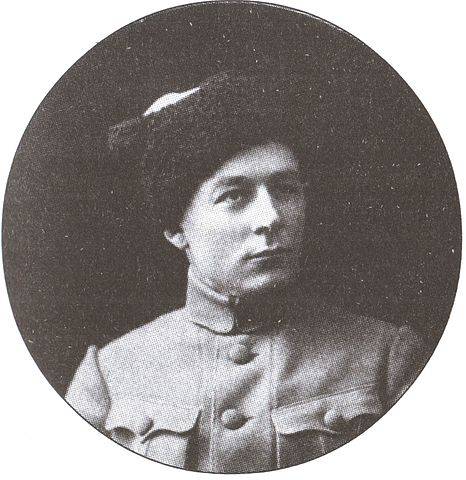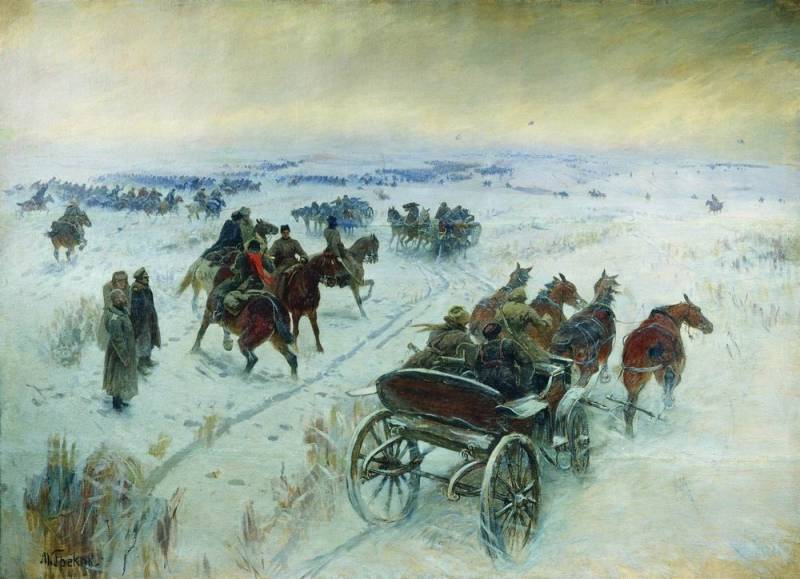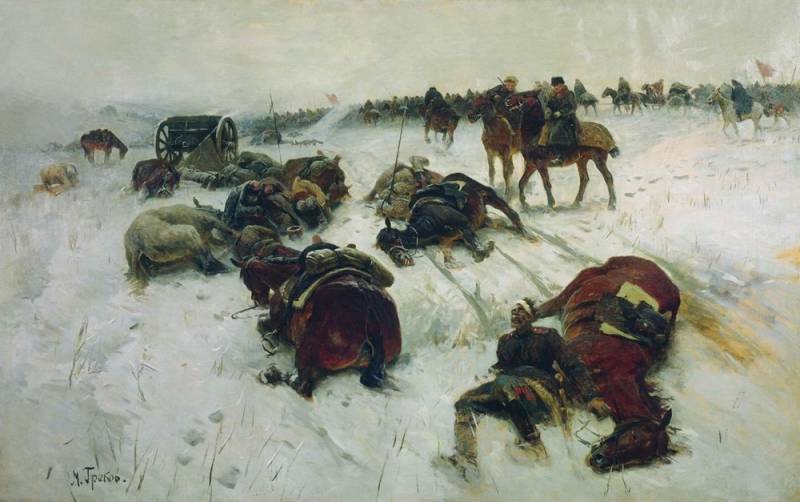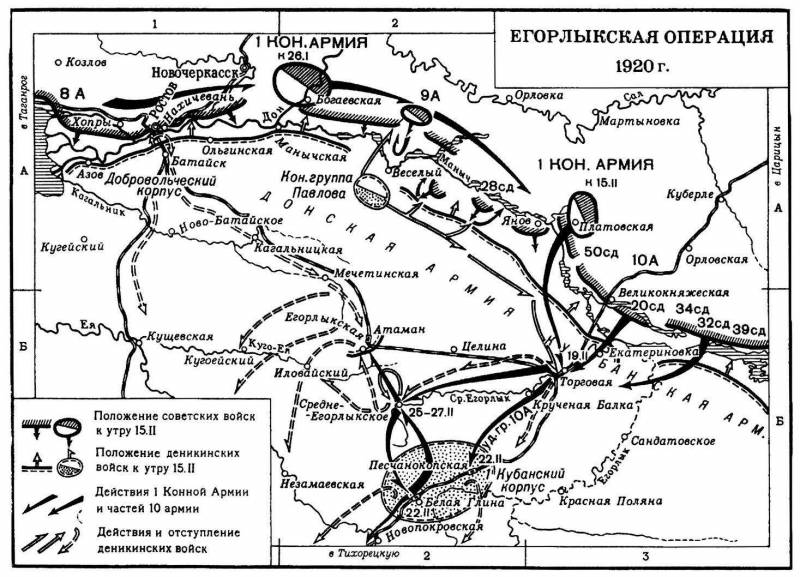The defeat of the army of Denikin in the battle of Tikhorets
100 years ago, in February 1920, the Soviet troops of the Caucasian Front conducted the Tikhoretskaya operation and inflicted a heavy defeat on Denikin’s army. The White Guard front collapsed, the remnants of the white troops randomly retreated, which predetermined the victory of the Red Army in the North Caucasus.
During the operation, the largest counter-horse battle of the Yegorlyksk during the entire Civil War took place, where the combined forces of both sides reached 25 thousand horsemen.
Kuban Troubles
While volunteers and donors fought on the Don-Manych front and won their last victories, the rear of Denikin’s army completely decayed. Despite the fact that the front approached directly to the Kuban, only a few thousand Kuban Cossacks remained in the army of Denikin. The rest of the Kuban deserted or went to their native villages for “reformation” (in fact, they deserted with the permission of the command). The process of "forming" new parts has taken on an endless nature. And the Kuban regiments, which still remained at the front, completely decomposed and were on the verge of collapse.
The Kuban “tops” began to boil again, which Denikin had only recently reassured with the help of General Pokrovsky. Major General Uspensky, the commander of the 4th Consolidated Horse Corps, who was elected ataman of the Kuban army, who tried to pursue a conciliatory policy, stayed at his post for only a month. He contracted typhoid and died. Left-wing politicians and autocrats immediately activated. Using the news of the defeats of Denikin’s army, which weakened the threat of the use of military force, they subjugated the Kuban Rada. The parliament canceled all concessions of the Union and restored its legislative functions. General Bukretov was elected the new Kuban chieftain. He fought bravely during the years of World War II on the Caucasian front, but during the time of troubles he was noted in abuses, was even arrested on charges of bribery.
Leading posts in the Rada and the regional government were occupied by supporters of independence and populists, who again headed for a split. Any decisions were made not out of necessity, but for the damage of the Supreme Command of the FYUR. The Social Revolutionaries, who spoke of the need for a coup, and the Mensheviks, who called for an agreement with the Bolsheviks, intensified. Nobody bothered them. All attempts to form a new army in the Kuban were sabotaged. General Wrangel planned to form a new horse army in the Kuban, there were people and material resources for this, but all his attempts were paralyzed by local politicians and officials.
On January 18, 1920, the Supreme Cossack Circle was assembled in Yekaterinodar: deputies from the Don, Kuban and Terek troops. The upper circle declared itself the "supreme power" in the Don, Kuban and Terek, and proceeded to create an "independent union state" in order to fight the Bolsheviks and establish internal freedom and order. It is clear that this stillborn initiative had no positive effect, only increased confusion and staggering. The deputies immediately quarreled with each other. Tertsy and most of the Don people stood for the continuation of the struggle with the Reds. Left Kuban and part of the Don people tended to reconciliation with the Bolsheviks. In addition, most of the Kuban people and part of the Don people advocated a break with the Denikin government. Denikin was declared a "reactionary" and put forward utopian projects for an alliance with Georgia, Azerbaijan, Petliura, and even green bands. Again, demands were made to limit the defense of the Kuban. Immediately there were dreams of “correcting the borders” of the Cossack regions due to the inclusion of part of the Voronezh, Tsaritsyn, Stavropol and Black Sea provinces.
Kuban army and the South Russian government
Westernizers who everywhere have their own interest did not stand aside. Bukretov was negotiating with the British and French on the creation of the South Russian "democratic" power. The Parliament announced that they will support England and provide everything necessary. True, General Holman immediately issued a refutation. The Supreme Circle had practically no power. But the fantastic picture of the decomposition of the rear and the inability to divert forces from a front that was crashing at the seams did not allow Denikin to restore order. He could only threaten the departure of volunteers, which somewhat cooled the hot heads in the rear. Engaging in “politics” and verbiage was good under the protection of the White Guard bayonets. The arrival of the Bolsheviks would quickly end this bacchanalia (which soon happened).
Therefore, Denikin, in order to prevent a break with the hesitant and tired of the war mass of Cossacks, made concessions. So, he agreed to the creation of the Kuban army of the All-Union Union of Socialist Republic of Ukraine. It was created on February 8, 1920 by reforming the Caucasian Army, which became the Kuban. First, the new army was headed by the popular in the Kuban, Shkuro, then Ulagay. The army included the 1st, 2nd and 3rd Kuban corps.
Also, the Supreme Commander of the All-Union Socialist League of Ukraine conducted negotiations with representatives of the Circle on the creation of a national government. After the evacuation from Rostov, the Special Meeting was dissolved, it was replaced by a new government led by General Lukomsky under the Supreme Commander of the All-Union Socialist League. The composition of the government was the same, but in a reduced composition. And the territory controlled by Denikin’s army sharply decreased - to the Black Sea province, part of Stavropol and Crimea. Now they planned to form a new government with the participation of the Cossacks. As a result, Denikin lost and went to an agreement with representatives of the Don region, Kuban and Terek. The troops of the Cossack state formations were under operational control of Denikin, and their representatives were part of the new government. In March 1920, the South Russian government was established. Denikin was declared the head of the new government. N.M. Melnikov (chairman of the Don government) became the head of the government, and General A.K. Kelchevsky (chief of staff of the Don Army) became the military and naval minister. True, this new government lasted only until the end of March, as the white front in the North Caucasus collapsed.
At the same time, the Kuban government refused to recognize the new South Russian government. Kuban continued to decompose. Replenishment from here to the front completely stopped. This caused a conflict with the Don people, who tried to force the Kuban to fight. It even reached the sending of Don punitive detachments to the Kuban villages to force the Cossacks to go to the front. But without success. It turned out to be impossible. The Kuban people turned their backs on the Denikin government and began to join the ranks of the rebels and the Reds. Local "greens" have stepped up, which attacked communications with Novorossiysk. The appointment of Shkuro, the former idol of the Kuban, did not help the commander of the new Kuban army. He was for unity with Denikin, so local politicians criticized him severely.
The Kuban chieftain Bukretov conducted a frank anti-Denikin policy, discussed with the independents the replacement of the South Russian government with a directory of atamans of the three Cossack troops. Independents dreamed of a Cossack dictator who would expel "strangers" and declare Kuban power. Kuban plunged into complete chaos.
New Caucasian Front
In addition, Denikin in this atmosphere of chaos received another front. On the territory of Georgia, the Russian Mensheviks and Socialist Revolutionaries in the autumn of 1919 established the Black Sea Liberation Committee, headed by Vasily Filippovsky. Of the 11th and 12th Soviet armies interned in the Georgian Republic, the Black Sea rebel peasants began to form an army. It was provided and armed by the Georgian government, trained by Georgian officers. On January 28, 1920, the army of the Committee (about 2 thousand people) crossed the border and launched an offensive in the Black Sea province.
In this direction stood the 52nd White Brigade. But the brigade had low combat efficiency, several of its battalions were small and unreliable. They mainly consisted of captured Red Army soldiers. They did not run away just because there was nowhere to run, the house was too far away. Simultaneously with the advance of the Committee’s troops, the local “greens” began to go behind the White Guards. The Denikins attacked from two sides were scattered, some fled, others surrendered. The troops of the Committee occupied Adler, February 2 - Sochi. Here, the Committee announced the creation of an independent Black Sea Republic. He called on the Kuban Rada to enter into an alliance.
Then the troops of the Black Sea Republic launched an offensive to the north. The commander of the troops of the Black Sea coast of the FYUR General Lukomsky had almost no troops, only small unreliable units that easily crossed over to the enemy’s side. The 2nd Infantry Division was thrown into battle (the division only by name, no larger than the battalion in size), which was "reinforced" by local replenishment. In the first battle, she was defeated, replenishment went over to the side of the rebels.
Due to the inability to fulfill duties, Lukomsky resigned. The new commander was Major General Burnevich. Meanwhile, the troops of the Black Sea Republic continued to advance. Contractions occurred according to one pattern. The White Guards, having gathered a few companies or battalions around the world, put up a screen in a convenient position between the mountains and the sea. The Greens, who knew the area well, easily bypassed the enemy, attacked from behind. Panic began, White's defense fell apart. Having won and divided the trophies, the local "green" went home and celebrated success for some time. It all started again. White lined up a new line of defense. The rebel army bypassed them. As a result, on February 11, the Greens occupied Lazarevskaya and began to threaten Tuapse. At this time, Georgia, in the guise of war, “fixed” the border with Russia in its favor.
Tikhoretskaya operation
The main thing was decided not at meetings and in offices, but at the front. In January - early February 1920, the Reds during the Don-Manych operation were unable to overcome the defenses of the White Guards in the Don area, and their main strike formations (Budenny Horse Army and the 2nd Dumenko Horse Corps) were repelled and suffered significant casualties and weapons. The Red Army failed to force the Don in the lower reaches, where volunteers defended, reached Manych, but failed to gain a foothold on its left bank. Front command changed. Shorin, who came into conflict with Budenny and his headquarters, was replaced by “winner Kolchak” Tukhachevsky.
Both sides were preparing to continue the battle. The forces of the parties were approximately equal: the Red Army - over 50 thousand bayonets and sabers (including about 19 thousand sabers) with 450 guns, the White Army - about 47 thousand people (including over 25 thousand sabers), 450 guns. Both white and red planned to advance. It seemed to the white command that not everything was lost yet and that it was possible to go on the counterattack. Smash the red Caucasian front. The fighting spirit of volunteers and donors after victories near Bataysk and Manych has increased. Moreover, after the agreements reached with the Cossacks, Kuban divisions and reinforcements were expected to appear on the front. There was a combat-ready strike group of Pavlov. The equestrian group of General Starikov was formed from the Don. On February 8, 1920, Denikin issued an order to transfer to the general offensive of the northern group of forces with the main strike in the Novocherkassk direction in order to capture Rostov and Novocherkassk. A transition to the offensive was planned in the near future, at which time the Kuban army (the former Caucasus) was to receive replenishment.
Meanwhile, the Soviet command was preparing a new offensive with the aim of breaking through the White’s defense on the river. Manych, the defeat of the North Caucasian group and the purification of the region from the White Guards. The offensive began on the entire front: the forces of the 8th, 9th, 10th were to force Don and Manych, defeat the opposing forces of the enemy. Sokolnikov's 8th army attacked in the direction of Kagalnitskaya with the goal of breaking through the defense of the Volunteer and 3rd Don corps in order to reach the river. Kahalnik; The 9th Dushkevich army was to break through the defenses of the 3rd and 1st Don Corps; Pavlov’s 10th Army opposed the Kuban Army; The 11th army of Vasilenko dealt a blow in the direction of Stavropol-Armavir.
But the main attack was dealt by the 1st Cavalry Army with the support of the rifle divisions of the 10th Army. The infantry was supposed to break through the enemy defenses, cavalry was introduced into the breach, which would separate the enemy armies and destroy them in parts. For this, a regrouping of forces was carried out. The 1st Horse Army of Budenny was transferred to the Platovskaya - Grand Ducal region, from where it was supposed to strike at Torgovaya - Tikhoretskaya, at the junction of the Don and Kuban armies. Reinforcements were being drawn up to the 10th and 11th armies through Tsaritsyn and Astrakhan at the expense of the troops, which were liberated after the liquidation of the Kolchakites and the Urals.
The offensive of the Caucasian front. Counterattacks of Denikin's army
On February 14, 1920, the Red Army launched an offensive. Attempts by the forces of the 8th and 9th armies to force Don and Manych to success did not lead. Only in the evening of February 15, the cavalry division of the 9th army and the 1st Caucasian cavalry division of the 10th army managed to force Manych and take up a small bridgehead. On the site of the 10th army, the situation was better. She piled on the weak Kuban army. She retreated. The Kuban army did not receive the promised replenishment, only one plastunsky (infantry) small corps of General Kryzhanovsky, who defended the Tikhoretsky direction, approached the beginning of the battle. The 10th Army, reinforced by the 50th and 34th Rifle Divisions of the 11th Army, was able to overcome the resistance of the 1st Kuban Corps and on February 16 captured Torgovaya. The army of Budenny was introduced into the breakthrough - the 4th, 6th and 11th cavalry divisions (about 10 thousand sabers). The Red Cavalry went up the Bolshoy Yegorlyk River to the rear of the Trade, threatening communications with Tikhoretskaya.
The White Command sent for the liquidation of the equestrian group of General Pavlov - the 2nd and 4th Don corps (about 10-12 thousand horsemen), which previously stood opposite the 9th Soviet Army. The Pavlov group, following up Manych, was supposed to strike the flank and rear of the enemy strike force together with the 1st Right-flank Don Corps. On February 16-17, the white cavalry overturned on the lower Manych part of the equestrian corps of Dumenko (2nd Cavalry Division) and the 1st Caucasian Cavalry Division of Guy from the 10th Army. On February 17, the White Cossacks inflicted a strong blow on the 28th Infantry Division. The commander Vladimir Azin was captured (he was executed on February 18). The Reds retreated behind Manych. Pavlov’s group continued to move to Torgovaya, which the Kuban had already left.
As Denikin noted, this forced march of Pavlov’s cavalry to Torgovaya was the beginning of the end of the white cavalry. Contrary to the advice of his subordinates, who spoke of the need to move along the right inhabited coast, General Pavlov moved along the almost uninhabited left bank of Manych. There were severe frosts and blizzards. Rare farms and winteries could not warm such a mass of people. As a result, Pavlov’s equestrian group was terribly exhausted, exhausted and morally broken. She lost almost half of her composition to frozen, frostbite, sick and lagging behind. Pavlov himself received a frostbite. Many froze right in the saddles. On February 19, the White Cossacks tried to recapture Torgovaya, but were driven back by the Budennovites. General Pavlov led his group to the Sredne-Yegorlykskaya, continuing to bear the loss of the sick and frozen.
At the same time, the Volunteer Corps defeated red in the Rostov direction. In the battles of February 19-21, 1920, volunteers repelled the attacks of the 8th Soviet Army and themselves went on the counteroffensive. On February 21, Denikinites again captured Rostov and Nakhichevan-on-Don. This fleeting success caused an explosion of hope in Yekaterinodar and Novorossiysk. At the same time, the 3rd Don Corps of General Guselschikov launched a successful offensive in the direction of Novocherkassk, took the village of Aksayskaya, intercepting the railway link between Rostov and Novocherkassk. Further in the east, in the lower reaches of Manych, the 1st Don Corps of General Starikov successfully opposed the units of the 1st Horse Corps of Zhloba and the 2nd Horse Corps of Dumenko, and went to the village of Bogaevskaya. But these were the last successes of white against the backdrop of a general catastrophe.

Yegorlyk battle
The Soviet command formed a powerful strike force at the breakthrough site. The 1st Cavalry Army temporarily subordinated the 20th, 34th and 50th rifle divisions. The infantry formed an attack group under the command of Mikhail Velikanov (chief of the 20th division). Budyonny’s army and the 10th Army’s strike group, putting up a barrier to the north (part of the 11th Cavalry Division) against the Pavlov group, non-stop advancing along the Tsaritsyn-Tikhoretskaya railway. On February 21, the Budennovites took Sredne-Yegorlykskaya, and on February 22 Velikanov’s group took Peschanokopskaya. On February 22, the main forces of Budenny defeated the 1st Kuban Corps in the area of White Clay. The commander of the Kuban Corps, General Kryzhanovsky, died with his staff surrounded. The Kuban army fell apart, its remnants fled or surrendered. Small groups of the Kuban army concentrated in the area of Tikhoretskaya, Caucasian and on the approaches to Stavropol. Budyonny’s army turned north, where the threat of a flank counterattack by the White Army arose. The 20th and 50th Infantry, 4th, 6th and 11th Cavalry Divisions were directed against Pavlov's group. The 34th Infantry Division remained to cover the Tikhoretsk direction.
The White Command, seeing that movement to the north was impossible due to the defeat and collapse of the right wing (the Kuban Army) and the withdrawal of the Red strike group in the rear of the Don Army and the Volunteer Corps, stopped the attack on the Rostov-Novocherkassk direction. The rate of the Supreme Commander of the All-Union Union of Liberal Democratic Forces from Tikhoretskaya was transferred to Yekaterinodar. One building was immediately taken back to strengthen Pavlov’s horse group. On February 23, the 8th Army restored the former front line. Using the success of the 8th Soviet army, the neighboring 9th also went on the offensive. The 1st Don Corps retreated for Manych. By February 26, whites were driven back to their original positions on the entire front.
True, here the situation was overshadowed by the arrest of corps commander Dumenko. The commander was a real national nugget, selflessly fought for Soviet power, became one of the organizers of the red cavalry. But he came into conflict with Trotsky, speaking out against his policies in the army. On the night of February 23-24, by order of a member of the Caucasian Military Revolutionary Council, Smilgi Dumenko was arrested together with the headquarters of the Consolidated Cavalry Corps. The accusations were false - Dumenko was charged with the murder of the commissar of the corps Mikeladze and the organization of rebellion. In defense of Dumenko, Ordzhonikidze, Stalin and Egorov spoke out, but Trotsky's line prevailed. In May, a talented people's commander was shot.
On February 23, Pavlov’s group, having received reinforcements, went on the offensive and on the 24th rejected the 11th cavalry division of the Reds. White took Sredne-Yegorlykskaya and moved towards White Clay to go behind enemy lines. On February 25, the largest equestrian battle of the Civil War took place in the area south of Sredne-Yegorlykskaya. Up to 25 thousand fighters from both sides took part in it. The Don people believed that the main forces of the Reds were still marching on Tikhoretskaya, and they hadn’t taken measures for enhanced intelligence and protection. As a result, the Cossacks unexpectedly ran into the main forces of the Red Army. Reconnaissance of the Budyonny army on time discovered the enemy, the units turned around. On the left wing, the 6th cavalry division of Tymoshenko met the marching columns of the 4th Don Corps with machine-gun and artillery fire, and then attacked. The whites were overturned. The 2nd Don Corps, led by General Pavlov, went to the 20th Division in the center and began to deploy for attack, but then it was covered with artillery fire by the 4th Cavalry Division of Gorodovikov from the left wing, then the 11th Cavalry Division attacked from the right wing. in battle order to attack, but artillery fire of the 4th Cavalry Division fell from the right flank, and then the 11th Cavalry Division attacked from the east. After that, the 4th Cavalry Division went on the attack.
White cavalry was defeated, lost about 1 thousand people only prisoners, 29 guns, 100 machine guns and fled. The Reds took the Central Egorlykskaya. Pavlov’s troops retreated to Yegorlykskaya. The whites transferred the last available forces and reserves from Bataysk and Mechetinsky to the Yegorlykskaya - Ataman area. Volunteers, the 3rd cavalry corps of Yuzefovich, several separate Kuban brigades were pulled here. On February 26-28, the Budennovites, without the support of rifle divisions, tried to take Yegorlykskaya, but without success. The Red Command concentrated all available forces here, including the 20th Rifle, 1st Caucasus and 2nd Cavalry Divisions. March 1 - 2, in a stubborn battle in the area of Yegorlykskaya - Ataman, the whites were defeated. The whites retreated to Ilovaiskaya and Mechetinskaya and began a retreat in the north along the entire front. General Sidorin led the Don Army across the Kagalnik River, then on.
By early March, volunteers left Rostov, retreated to the right bank of the Don, but still restrained the onslaught of the 8th Soviet army. The right flank of the Volunteer Corps, the departure of neighboring donors, was forced to withdraw from Olginskaya. White suffered heavy losses. On March 2, units of the 8th Soviet Army took Bataisk, which they had so stubbornly stormed before. The Reds were halfway to Tikhoretskaya and the Caucasus. On the left wing of the Caucasus Front, units of the 11th Army reached the Divnoye-Kizlyar line. February 29, the Reds took Stavropol. In the rear of Denikin, the rebels captured Tuapse on February 24. Here, the “green” army, under the influence of red agitators and former Red Army soldiers, was proclaimed the “Black Sea Red Army”. The new red army launched an offensive in two directions: through mountain crossings to the Kuban, and to Gelendzhik and Novorossiysk. From complete annihilation, the remains of Denikin’s army were saved by the beginning of the thaw, the beginning of the thaw that turned the earth into impassable mud and swamps. The movement of the Red Army lost speed.
Thus, the army of Denikin suffered a decisive defeat. The Red Army broke through the defensive line on the Don and Manych, and advanced 100-110 km to the south. The white cavalry was completely bloodless and lost its striking power. The demoralized remnants of the Denikin army non-stop retreated to Ekaterinodar, Novorossiysk and Tuapse. In fact, the front of the White Army collapsed. Prerequisites were created for the complete liberation of the entire Kuban, Stavropol, Novorossiysk and the North Caucasus.



Information